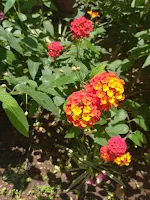One of my favorite bushes is the lantana. This is just one variety among dozens and it is the larger growing bush variety lantana camara, possibly the variety 'Radiation' I mentioned it before but it is now in full bloom and had to take pictures of the variation in the flowers.
It is well known for the combination of colors in each flower head and range from yellow/orange/red to white/pink, nothing dark or blue colored yet, closest is a lavender variety but that's a ground cover. This is a favorite flower of both butterflies and hummingbirds due to the type of flower and the coloring. Some people don't like it because it gets so big but there are now hybrids that stay smaller, maybe 3' tall and that or wider. perfect for smaller gardens where you still want that splash of color in the middle of summer and a bush that will stay green all year around.
If you have a hummingbird feeder but don't seem to be getting any hummers, this is one plant to put in your yard that will get some attention. It is also the favorite plant among many butterfly species like swallowtails and monarchs.
I mentioned watering the spare bed and letting it soak. Here's what it looks like about 24 hours later.
It's a little more level now and that small bit of green in the right corner is wild purslane, The soil was still very moist and easy to work so getting some amendment in there will be fun, as long as I can get a little shovel rather than using the hoe, cultivator or the trowel. (I pulled the purslane out after I took the picture). So this bed is about the right size for one 4" container of zucchini.
I saw a video the other day about staking up zucchini plants so it's easier to pick the fruit. The person said you can use a tomato cage but putting a stake down next to the stalk and then tying it up as it goes works best. I just remember zucchini plants sprawling all over and still being able to pick them. Will see how it works.... as soon as I get the amendment and the plant. Maybe next week. It gets so blasted hot by 11 am that I don't want to go anywhere.
Going to mention here when to know if you've got suckers coming up or what you planted. I got the question occasionally when I was working and depending on the plant you have to know what you're looking for.
Roses, it's easy.
The white rose is an Iceberg, common rose planted all over the country and very popular in So. California. Tough rose bush flowers a lot and takes little maintenance if you're inland. Now see the burgundy colored flowers? Those are the rootstock growing up and it's easy to tell because of the flower color but if it weren't flowering, and on other plants and trees as well, look to where the stems are coming from.
A good 99% of roses are all grafted as well as most fruit trees. Grafting is a process of taking a growing part of one plant and inserting it under the skin or into the core of another plant. Various reasons and it's a huge topic that I won't cover right now.
For roses the rootstock on most of them is a variety called Dr. Hurd. It really has no flower value for fragrance, it mildews easily and tends to just grow rampantly. Why do they use it then? It has a stronger root and is resistant to some diseases. It was never meant to be grown on it's own merits after it was discovered to have desirable traits for the hybrid industry.
So when you see something like this coming up you need to dig down and try to break or cut it off as close to where it is growing from. If your main rose doesn't seem to be growing, the whole thing comes out and toss it. Time to get a new one. The rootstock is so strong that when the grafted rose fails from age or disease or whatever, it takes over. We have a few in our planting beds around the complex. Makes me itch to get a shovel, dig it out and plant another rose.
Now as for fruit trees, on some there is an obvious bump within about a foot of the base of the tree called the 'graft collar' or 'graft junction' or 'bud union' depending on what type of graft and plant. Anything coming from below that point is suckers and needs to be removed.
See that little jog in the trunk? That's the graft joint and all those little branches are coming from below there need to come off. This is on a citrus tree and the leaves are very different than a standard citrus leaf so it's easy to tell. In this case you need to pull them off at a downward angle to get the growth point as well. If you don't it'll just keep growing new ones from that point.
A lot of people feel that killing suckers would harm the plant as if it were giving birth to babies. Oh heck no honey! they are called suckers for a reason, they will reduce the vitality of the tree or plant that may still be trying to grow so get them out of there!
Maybe if we called them leeches people wouldn't feel so bad about them.
Saw this on our corkboard in the patio... word to the wise. Lol!
The cartoon below it which I didn't get a picture of was two snails seemingly maybe a leaf distance between them and one is saying, 'If we weren't so far away I'd come over there and beat you up!'











No comments:
Post a Comment
Questions? Comments, Concerns...